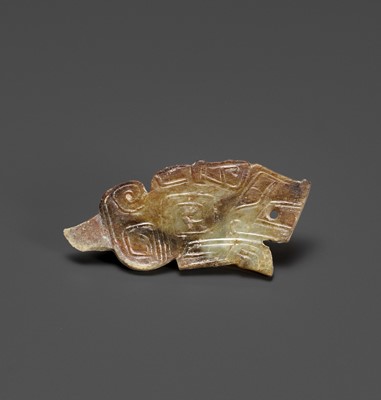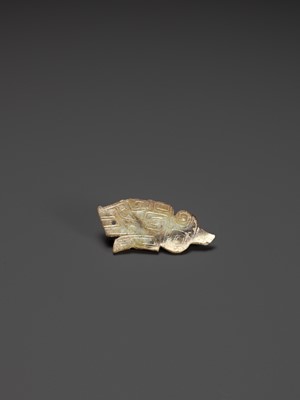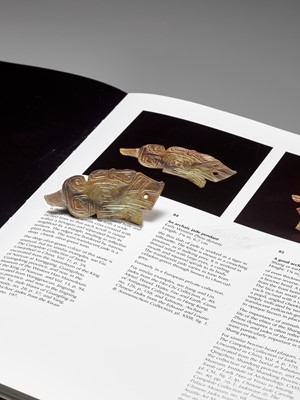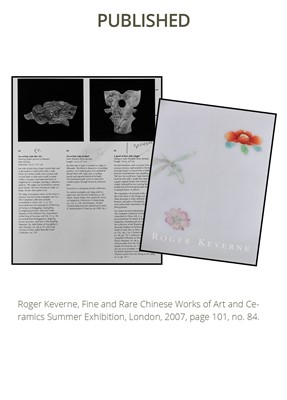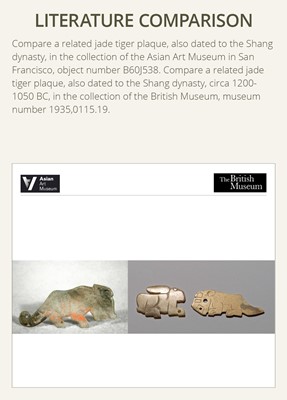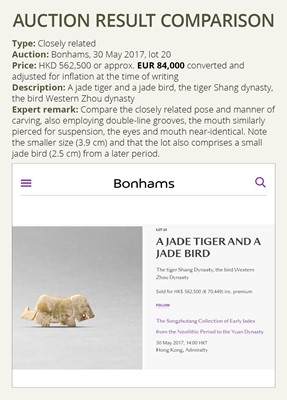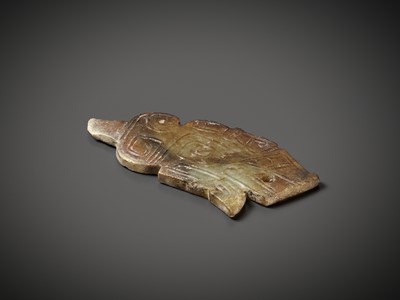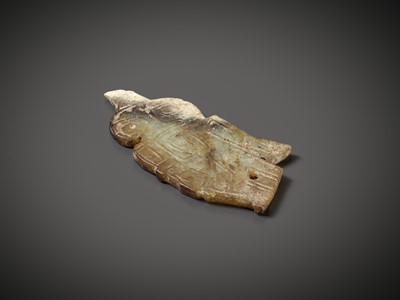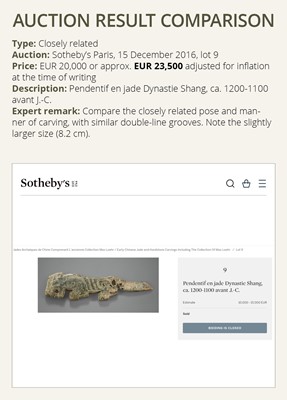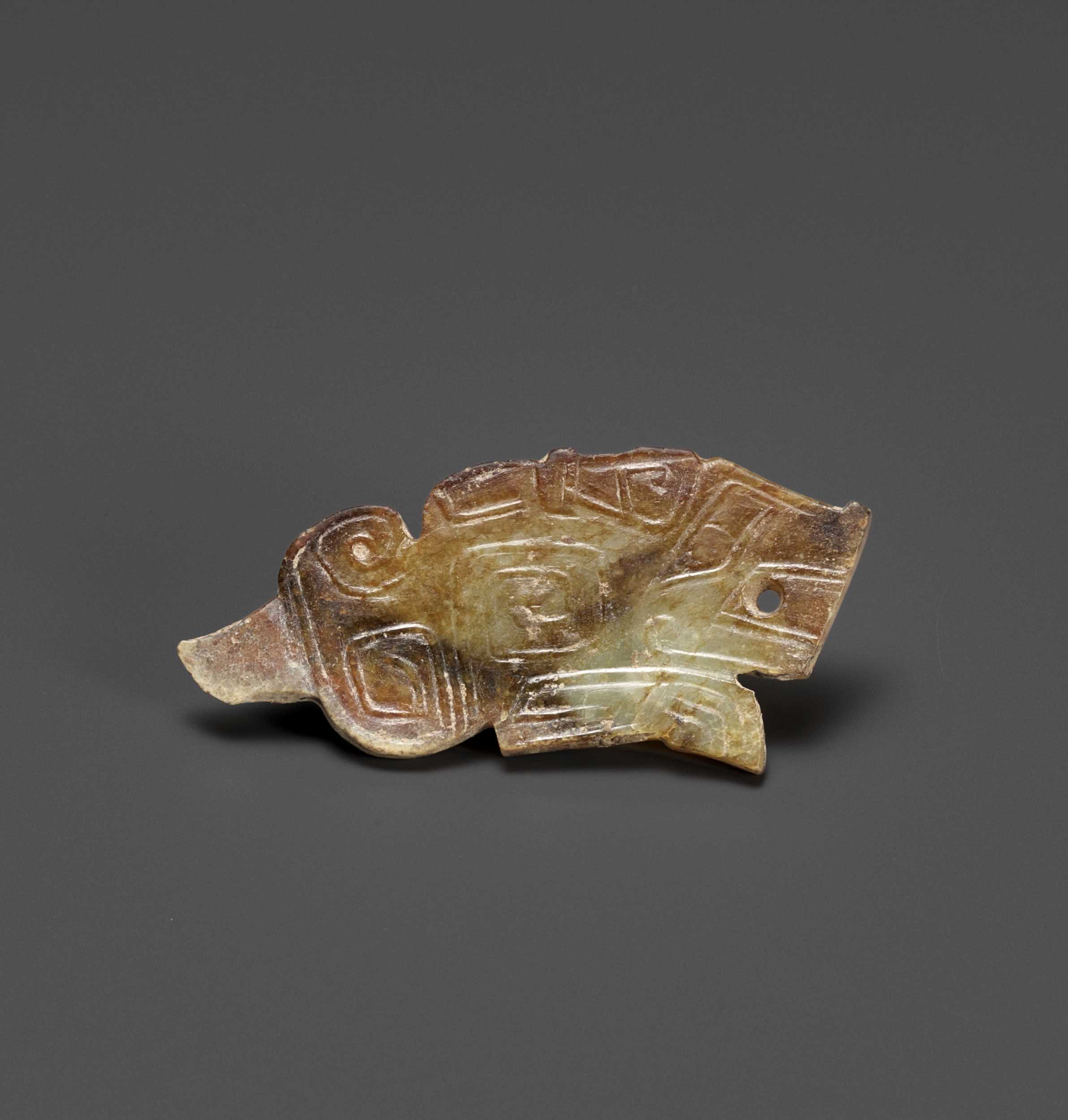29th Sep, 2022 13:00
DAY 1 - TWO-DAY AUCTION - Fine Chinese Art / 中國藝術集珍 / Buddhism & Hinduism
34
A TIGER-FORM JADE PENDANT, LATE SHANG DYNASTY
商末虎形青玉珮
Sold for €20,800
including Buyer's Premium
China, 13th-11th century BC. The crouching tiger carved in profile, the body well detailed and decorated with double-line grooves, the mouth pierced for suspension. The translucent stone of a celadon tone with extensive russet shading, some black patches, and small areas of alteration.
Provenance: A Western private collection. Roger Keverne Ltd., London, United Kingdom, December 2007. A distinguished English private collection, acquired from the above. Roger Keverne served as the Chairman of Asian Art in London and as the President of BADA. He began his 50-year career with Spink & Son, rising to head the Asian department by the age of only 28. He left Spink in 1992 to start his own gallery together with Miranda Clarke, his wife and business partner, in Mayfair, London, which eventually closed its doors in June 2020.
Published: Roger Keverne, Fine and Rare Chinese Works of Art and Ceramics Summer Exhibition, London, 2007, page 101, no. 84.
Condition: Very good condition overall with some old wear, traces of use and shallow surface scratches, an area of calcification to the tip of the tail with an associated minuscule loss. Fine, naturally grown patina. The jade with natural inclusions and fissures.
Weight: 11.3 g
Dimensions: Length 6.5 cm
An important stylistic feature of the present pendant is the use of the so-called double-line grooves. On first inspection, it appears that these rise in low relief. But in fact this is an optical illusion, or trompe-l’œil effect, as those slender “relief lines” are actually flush with the object’s surface and seem to rise in relief only because of the intaglio lines, or grooves, that flank them. Such trompe-l’œil lines are a rare feature, and found on the very finest Shang jades only.
The tiger, called hu or laohu in Chinese, is among the most recognizable of the world’s charismatic megafauna. Originating in China and northern Central Asia, the tiger was known to the earliest Chinese, who likely feared, admired, and respected it for its strength, ferocity, and regal bearing. Though its precise symbolism in Shang times (c. 1600–1046 BC) remains unknown, the tiger doubtless played a totemic, tutelary, or talismanic role. By the Western Han period (206 BC–AD 9)—a thousand years after this pendant was made—the tiger was regarded as the “king of the hundred beasts”, or baishou zhi wang, due to its power and ferocity and especially to the markings on its forehead which typically resemble the character wang, or “king”. In addition, not only did the tiger figure among the twelve animals of the Chinese zodiac, but it gained a place among the auspicious animals that symbolize the four cardinal directions—the white tiger, or baihu, of the west, the azure dragon of the east, the vermillion bird of the south, and the black tortoise of the north.
Literature comparison: Compare a related jade tiger plaque, also dated to the Shang dynasty, in the collection of the Asian Art Museum in San Francisco, object number B60J538. Compare a related jade tiger plaque, also dated to the Shang dynasty, circa 1200-1050 BC, in the collection of the British Museum, museum number 1935,0115.19.
Auction result comparison:
Type: Closely related
Auction: Bonhams, 30 May 2017, lot 20
Price: HKD 562,500 or approx. EUR 84,000 converted and adjusted for inflation at the time of writing
Description: A jade tiger and a jade bird, the tiger Shang dynasty, the bird Western Zhou dynasty
Expert remark: Compare the closely related pose and manner of carving, also employing double-line grooves, the mouth similarly pierced for suspension, the eyes and mouth near-identical. Note the smaller size (3.9 cm) and that the lot also comprises a small jade bird (2.5 cm) from a later period.
Auction result comparison:
Type: Closely related
Auction: Sotheby’s Paris, 15 December 2016, lot 9
Price: EUR 20,000 or approx. EUR 23,500 adjusted for inflation at the time of writing
Description: Pendentif en jade Dynastie Shang, ca. 1200-1100 avant J.-C.
Expert remark: Compare the closely related pose and manner of carving, with similar double-line grooves. Note the slightly larger size (8.2 cm).
商末虎形青玉珮
中國,公元前十三至十一世紀。珮呈扁片狀,以陰刻雙線技法雕琢半蹲老虎的側身形,虎口處,琢一小穿。局部淺褐色沁。
來源:西方私人收藏 ;英國倫敦Roger Keverne Ltd.藝廊,2007年12月;一個傑出的英國私人收藏,購於上述藝廊。Roger Keverne曾任倫敦亞洲藝術主席和BADA總裁。他在 Spink & Son 開始了 50 年的職業生涯,年僅 28 歲就升任亞洲部負責人。他於 1992 年離開 Spink,與他的妻子兼商業夥伴 Miranda Clarke 一起在倫敦梅菲爾開設了自己的畫廊 ,最終於 2020年 6 月關門。
出版:Roger Keverne,《Fine and Rare Chinese Works of Art and Ceramics Summer Exhibition》,2007年,倫敦,頁101,編號84.
品相:整體狀況極好,有一些磨損、使用痕跡和表面淺劃痕、尾部尖端有鈣化區域以及相應的微小缺損。細膩的包漿,有天然內沁和裂縫的玉料。
重量:11.3 克
尺寸:長 6.5 厘米
這件玉珮一個重要特徵是使用了雙線技法。細長的“浮雕線”實際上與物體表面齊平,並且似乎只是因為它們側面的凹線或凹槽而隆起。 這種錯視線條是一種罕見的特徵,僅在最上等的商代玉器上才能找到。
虎,堪稱百獸之王,中國虎文化淵遠流長,它很早就成為中國的圖騰之一。雖然它在商代(約西元前 1600-1046 年)的確切象徵意義仍然未知,但老虎無疑扮演了圖騰、守護神或護身符的角色。虎不僅在十二生肖中佔有一席之地,而且在古代文學中以青龍、白虎、朱雀、玄武四種圖像象徵東、南、西、北4個方位。老虎也是一種文化現象,它常被視為權力和製度的象徵,也是古代文學藝術描繪的對象。這充分體現虎與人類的密切關係和虎文化對世人的影響。
文獻比較:比較一件相近的商代虎形青玉珮,收藏於舊金山亞洲博物館,編號B60J538。比較一件相近的商代大約公元前1200-1050年虎形青玉珮 ,收藏於大英博物館,編號1935,0115.19。
拍賣結果比較:
形制:非常相近
拍賣:邦瀚斯,2017年5月30日,lot 20
價格:HKD 562,500(相當於今日EUR 84,000)
描述:商晚期玉虎及西周小玉鳥
專家評論:比較非常相近的姿勢和雕刻風格、陰刻雙線技法、虎口小穿孔,眼睛和虎口幾乎相同。請注意尺寸較小(3.9厘米) ,以及此虎形佩還搭配一個年代較晚的小玉鳥佩 (2.5厘米) 。
拍賣結果比較:
形制:非常相近
拍賣:巴黎蘇富比,2016年12月15日,lot 9
價格:EUR 20,000(相當於今日EUR 23,500)
描述:商 玉虎紋珮
專家評論:比較非常相近的姿勢和雕刻風格、陰刻雙線技法。請注意尺寸較大(8.2厘米)。
China, 13th-11th century BC. The crouching tiger carved in profile, the body well detailed and decorated with double-line grooves, the mouth pierced for suspension. The translucent stone of a celadon tone with extensive russet shading, some black patches, and small areas of alteration.
Provenance: A Western private collection. Roger Keverne Ltd., London, United Kingdom, December 2007. A distinguished English private collection, acquired from the above. Roger Keverne served as the Chairman of Asian Art in London and as the President of BADA. He began his 50-year career with Spink & Son, rising to head the Asian department by the age of only 28. He left Spink in 1992 to start his own gallery together with Miranda Clarke, his wife and business partner, in Mayfair, London, which eventually closed its doors in June 2020.
Published: Roger Keverne, Fine and Rare Chinese Works of Art and Ceramics Summer Exhibition, London, 2007, page 101, no. 84.
Condition: Very good condition overall with some old wear, traces of use and shallow surface scratches, an area of calcification to the tip of the tail with an associated minuscule loss. Fine, naturally grown patina. The jade with natural inclusions and fissures.
Weight: 11.3 g
Dimensions: Length 6.5 cm
An important stylistic feature of the present pendant is the use of the so-called double-line grooves. On first inspection, it appears that these rise in low relief. But in fact this is an optical illusion, or trompe-l’œil effect, as those slender “relief lines” are actually flush with the object’s surface and seem to rise in relief only because of the intaglio lines, or grooves, that flank them. Such trompe-l’œil lines are a rare feature, and found on the very finest Shang jades only.
The tiger, called hu or laohu in Chinese, is among the most recognizable of the world’s charismatic megafauna. Originating in China and northern Central Asia, the tiger was known to the earliest Chinese, who likely feared, admired, and respected it for its strength, ferocity, and regal bearing. Though its precise symbolism in Shang times (c. 1600–1046 BC) remains unknown, the tiger doubtless played a totemic, tutelary, or talismanic role. By the Western Han period (206 BC–AD 9)—a thousand years after this pendant was made—the tiger was regarded as the “king of the hundred beasts”, or baishou zhi wang, due to its power and ferocity and especially to the markings on its forehead which typically resemble the character wang, or “king”. In addition, not only did the tiger figure among the twelve animals of the Chinese zodiac, but it gained a place among the auspicious animals that symbolize the four cardinal directions—the white tiger, or baihu, of the west, the azure dragon of the east, the vermillion bird of the south, and the black tortoise of the north.
Literature comparison: Compare a related jade tiger plaque, also dated to the Shang dynasty, in the collection of the Asian Art Museum in San Francisco, object number B60J538. Compare a related jade tiger plaque, also dated to the Shang dynasty, circa 1200-1050 BC, in the collection of the British Museum, museum number 1935,0115.19.
Auction result comparison:
Type: Closely related
Auction: Bonhams, 30 May 2017, lot 20
Price: HKD 562,500 or approx. EUR 84,000 converted and adjusted for inflation at the time of writing
Description: A jade tiger and a jade bird, the tiger Shang dynasty, the bird Western Zhou dynasty
Expert remark: Compare the closely related pose and manner of carving, also employing double-line grooves, the mouth similarly pierced for suspension, the eyes and mouth near-identical. Note the smaller size (3.9 cm) and that the lot also comprises a small jade bird (2.5 cm) from a later period.
Auction result comparison:
Type: Closely related
Auction: Sotheby’s Paris, 15 December 2016, lot 9
Price: EUR 20,000 or approx. EUR 23,500 adjusted for inflation at the time of writing
Description: Pendentif en jade Dynastie Shang, ca. 1200-1100 avant J.-C.
Expert remark: Compare the closely related pose and manner of carving, with similar double-line grooves. Note the slightly larger size (8.2 cm).
商末虎形青玉珮
中國,公元前十三至十一世紀。珮呈扁片狀,以陰刻雙線技法雕琢半蹲老虎的側身形,虎口處,琢一小穿。局部淺褐色沁。
來源:西方私人收藏 ;英國倫敦Roger Keverne Ltd.藝廊,2007年12月;一個傑出的英國私人收藏,購於上述藝廊。Roger Keverne曾任倫敦亞洲藝術主席和BADA總裁。他在 Spink & Son 開始了 50 年的職業生涯,年僅 28 歲就升任亞洲部負責人。他於 1992 年離開 Spink,與他的妻子兼商業夥伴 Miranda Clarke 一起在倫敦梅菲爾開設了自己的畫廊 ,最終於 2020年 6 月關門。
出版:Roger Keverne,《Fine and Rare Chinese Works of Art and Ceramics Summer Exhibition》,2007年,倫敦,頁101,編號84.
品相:整體狀況極好,有一些磨損、使用痕跡和表面淺劃痕、尾部尖端有鈣化區域以及相應的微小缺損。細膩的包漿,有天然內沁和裂縫的玉料。
重量:11.3 克
尺寸:長 6.5 厘米
這件玉珮一個重要特徵是使用了雙線技法。細長的“浮雕線”實際上與物體表面齊平,並且似乎只是因為它們側面的凹線或凹槽而隆起。 這種錯視線條是一種罕見的特徵,僅在最上等的商代玉器上才能找到。
虎,堪稱百獸之王,中國虎文化淵遠流長,它很早就成為中國的圖騰之一。雖然它在商代(約西元前 1600-1046 年)的確切象徵意義仍然未知,但老虎無疑扮演了圖騰、守護神或護身符的角色。虎不僅在十二生肖中佔有一席之地,而且在古代文學中以青龍、白虎、朱雀、玄武四種圖像象徵東、南、西、北4個方位。老虎也是一種文化現象,它常被視為權力和製度的象徵,也是古代文學藝術描繪的對象。這充分體現虎與人類的密切關係和虎文化對世人的影響。
文獻比較:比較一件相近的商代虎形青玉珮,收藏於舊金山亞洲博物館,編號B60J538。比較一件相近的商代大約公元前1200-1050年虎形青玉珮 ,收藏於大英博物館,編號1935,0115.19。
拍賣結果比較:
形制:非常相近
拍賣:邦瀚斯,2017年5月30日,lot 20
價格:HKD 562,500(相當於今日EUR 84,000)
描述:商晚期玉虎及西周小玉鳥
專家評論:比較非常相近的姿勢和雕刻風格、陰刻雙線技法、虎口小穿孔,眼睛和虎口幾乎相同。請注意尺寸較小(3.9厘米) ,以及此虎形佩還搭配一個年代較晚的小玉鳥佩 (2.5厘米) 。
拍賣結果比較:
形制:非常相近
拍賣:巴黎蘇富比,2016年12月15日,lot 9
價格:EUR 20,000(相當於今日EUR 23,500)
描述:商 玉虎紋珮
專家評論:比較非常相近的姿勢和雕刻風格、陰刻雙線技法。請注意尺寸較大(8.2厘米)。
Zacke Live Online Bidding
Our online bidding platform makes it easier than ever to bid in our auctions! When you bid through our website, you can take advantage of our premium buyer's terms without incurring any additional online bidding surcharges.
To bid live online, you'll need to create an online account. Once your account is created and your identity is verified, you can register to bid in an auction up to 12 hours before the auction begins.
Intended Spend and Bid Limits
When you register to bid in an online auction, you will need to share your intended maximum spending budget for the auction. We will then review your intended spend and set a bid limit for you. Once you have pre-registered for a live online auction, you can see your intended spend and bid limit by going to 'Account Settings' and clicking on 'Live Bidding Registrations'.
Your bid limit will be the maximum amount you can bid during the auction. Your bid limit is for the hammer price and is not affected by the buyer’s premium and VAT. For example, if you have a bid limit of €1,000 and place two winning bids for €300 and €200, then you will only be able to bid €500 for the rest of the auction. If you try to place a bid that is higher than €500, you will not be able to do so.
Online Absentee and Telephone Bids
You can now leave absentee and telephone bids on our website!
Absentee Bidding
Once you've created an account and your identity is verified, you can leave your absentee bid directly on the lot page. We will contact you when your bids have been confirmed.
Telephone Bidding
Once you've created an account and your identity is verified, you can leave telephone bids online. We will contact you when your bids have been confirmed.
Classic Absentee and Telephone Bidding Form
You can still submit absentee and telephone bids by email or fax if you prefer. Simply fill out the Absentee Bidding/Telephone bidding form and return it to us by email at office@zacke.at or by fax at +43 (1) 532 04 52 20. You can download the PDF from our Upcoming Auctions page.
How-To Guides
How to Create Your Personal Zacke Account
How to Register to Bid on Zacke Live
How to Leave Absentee Bids Online
How to Leave Telephone Bids Online
中文版本的操作指南
创建新账号
注册Zacke Live在线直播竞拍(免平台费)
缺席投标和电话投标
Third-Party Bidding
We partner with best-in-class third-party partners to make it easy for you to bid online in the channel of your choice. Please note that if you bid with one of our third-party online partners, then there will be a live bidding surcharge on top of your final purchase price. You can find all of our fees here. Here's a full list of our third-party partners:
- 51 Bid Live
- EpaiLive
- ArtFoxLive
- Invaluable
- LiveAuctioneers
- the-saleroom
- lot-tissimo
- Drouot
Please note that we place different auctions on different platforms. For example, in general, we only place Chinese art auctions on 51 Bid Live.
Bidding in Person
You must register to bid in person and will be assigned a paddle at the auction. Please contact us at office@zacke.at or +43 (1) 532 04 52 for the latest local health and safety guidelines.
